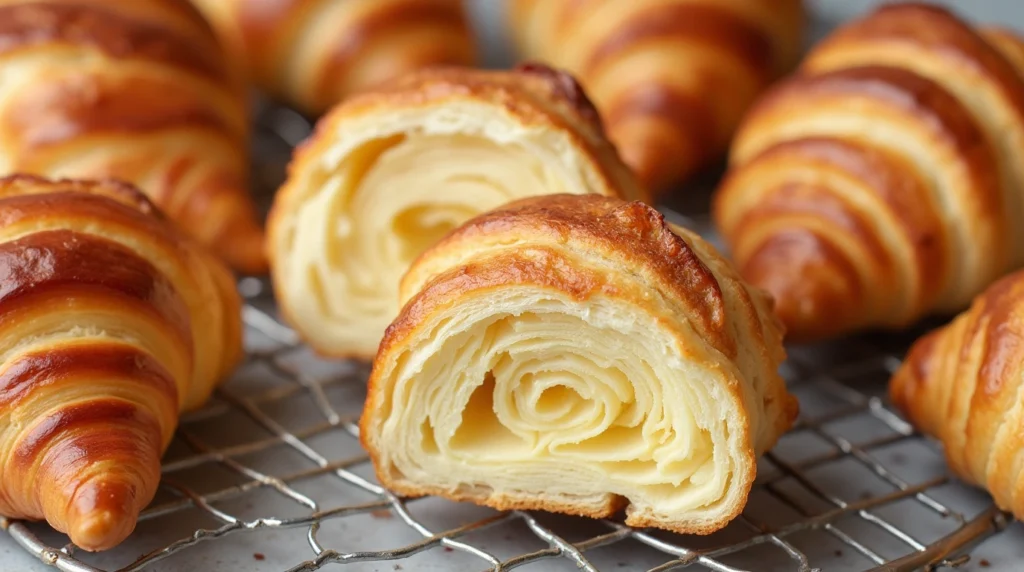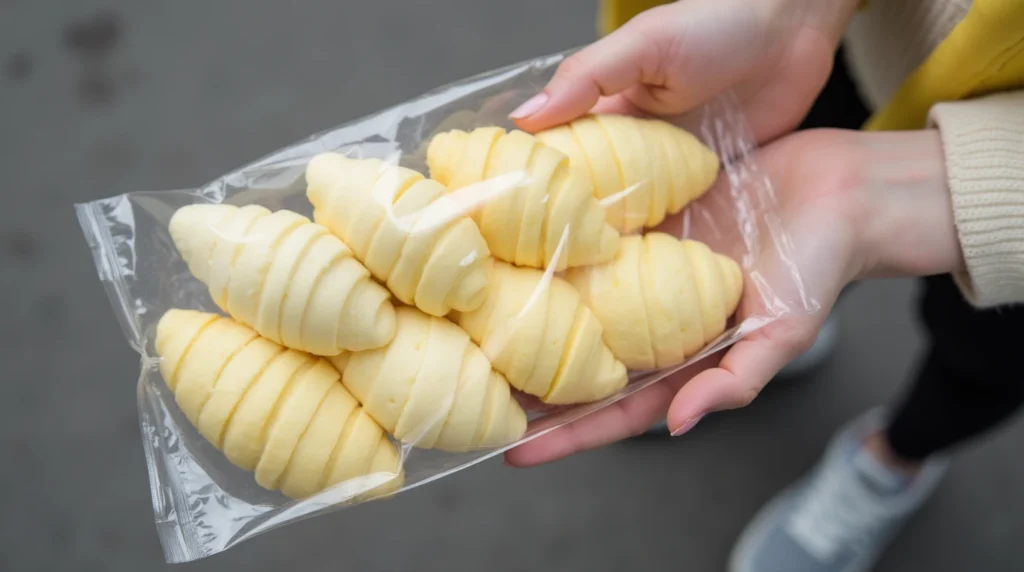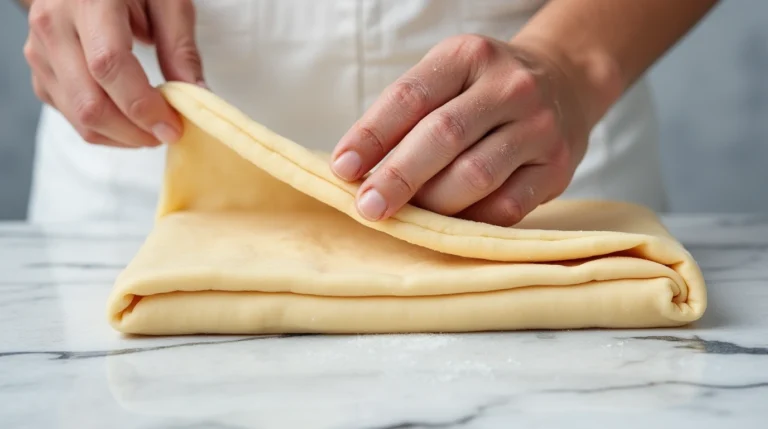That first bite of a perfectly crafted croissant is pure magic. The delicate crackle of its golden crust, the buttery richness that melts effortlessly on your tongue, and the joy it brings these moments linger in your memory as culinary treasures. A croissant is more than a pastry; it’s a masterpiece of textures, flavors, and aromas, created by transforming simple ingredients through precise techniques. It all starts with the dough, that humble yet extraordinary foundation. Join me as we uncover the secrets behind turning flour, butter, and yeast into layers of flaky perfection. Let’s dive into this baking adventure!
Demystifying Croissant Dough: From Basics to Brilliance
Croissant dough is far from ordinary it’s a masterpiece of precision, patience, and artistry. Think of it as an architectural endeavor, where every step matters. What sets it apart from other doughs? The magic lies in lamination: the meticulous layering of butter between sheets of dough. This isn’t just mixing ingredients; it’s a process that blends flavors and textures in perfect harmony. The result? A golden, crisp crust encasing an airy, flaky interior. Those signature layers and air pockets are the essence of a true croissant. Together, we’ll unravel this incredible process, step by step, to create baking magic.
- What is Croissant Dough? To clarify, it’s a yeasted, laminated dough. Envision a beautiful composition of leavened dough, which provides lift and volume, combined with an abundance of butter, which is responsible for creating those coveted flaky layers we all adore. This makes it an utterly unique dough in the baking world, unlike any other you might have encountered.
- Key Players: Butter and Lamination: The butter is not just a mere addition; it is the heart, the very lifeblood of the croissant. It’s what gives it that distinct texture and luxuriously rich flavor. Lamination, which essentially is the repetitive process of folding and turning the dough, is the choreography that brings it all to life. The layering creates tiny pockets of flavor and buttery goodness with every bite.
- How it differs: This dough is entirely different from the kind you’d use to make regular bread. It’s also vastly different from pie dough, which uses shortening and does not contain any yeast. Although they both involve layers, the processes, the ingredients, and the resulting products are completely different. Croissant dough requires a more complex method and a labor-intensive process, but the results, however, are unequivocally worth every single step.
Is Croissant Dough the Same as Pie Crust? A Head-to-Head Comparison
Let’s address a frequent question and put any lingering misconceptions to rest: no, croissant dough is certainly not interchangeable with pie crust. They are both dough, yes, but that’s pretty much where the similarities end. To think that they are interchangeable is like saying that a soaring majestic hawk and a small, humble sparrow are the same. They are both birds, yes, but they have completely different attributes, habits, and environments. Similarly, both croissant dough and pie crust have their distinct qualities, methods of preparation, and purposes, making one different from the other in a fundamental way. Substituting one for the other will not give you the desired results.
- The Ingredients: Pie crust mainly uses fats, like shortening or cold butter with very basic ingredients, such as flour and water. Croissant dough, on the other hand, adds the complexity of yeast, a leavening agent responsible for its volume, and also needs more butter to facilitate the lamination process. That’s how those beautiful layers are created. The fat and flour ratio in both is also very different, thus creating a vastly different result.
- Technique that defines each: Making pie crust is a simple process, involving the mixing of the ingredients, and then chilling, before rolling it out. The technique is usually easy and quick to learn. Croissant dough, however, demands a more time-consuming and meticulous process of lamination, that involves a dance of dough and butter, and this must be done with precision, care, and a lot of patience. It is a true labor of love and a quick-fix solution.
- The Verdict – Key Differences: Croissant dough is best characterized by its layered, flaky, and airy texture, which comes from the yeast, and the lamination process. Pie crust, on the other hand, is non-yeasted and is more of a short, sturdy, and crumbly type of dough, which is made to withstand the moisture of pie fillings. Therefore, it’s clear that their techniques and intended purposes differ greatly, making each dough unique in its own right.


How Do I Make Successful Croissant Dough? A Step-by-Step Guide
Now, it’s your turn to craft buttery, flaky wonders! This isn’t a quick recipe it’s a time-honored process requiring patience and precision. From ingredient temperatures to handling the dough gently, every step matters. Embrace the journey, and together, we’ll create something wonderful and delicious, one step at a time.
The Essential Ingredients (Table Form):
Table of Contents
Here’s a detailed table showcasing the essential ingredients you’ll need, with careful consideration. Remember, the quality of the ingredients will directly impact the final result, so try to use the very best quality you can get your hands on.
| Ingredient | Quantity | Importance |
| All-purpose Flour | 500g | This provides the primary structure of the dough and gives it its foundation. It’s the element that binds everything together. |
| Active Dry Yeast | 10g | This is your leavening agent, the secret to that gorgeous rise and airy texture, it changes the dough and gives it a life of its own. |
| Granulated Sugar | 50g | The magical ingredient gives those flaky layers, as well as that rich buttery flavour that is so characteristic of the croissant. It’s used gradually during the process. |
| Salt | 10g | It serves as a food source for the yeast and gives it the energy it needs to grow. It also adds a subtle touch of sweetness, enhancing the overall flavor of the final product. |
| Cold Water | 250g | This hydrates the flour and activates the yeast and needs to be cold to avoid activating the yeast too early and to maintain the temperature of the butter. |
| Unsalted Butter | 250g | The magical ingredient gives those flaky layers, as well as that rich buttery flavor that is so characteristic of the croissant. It’s used gradually during the process. |
Step-by-Step Guide with Flavor Descriptions and a Touch of Humor
Alright, let’s don our baker’s hats, and let’s get to it!
- Mixing the Dough: In a large mixing bowl, thoroughly combine the flour, yeast, sugar, and salt. Slowly add the cold water while gently mixing it with your hands or with a spatula, until a rough, shaggy dough begins to form. At this stage, you’ll begin to notice a soft, earthy aroma, as the flour mixes with the water, a subtle hint of the magic to come. Knead the dough on a lightly floured surface for about 5-7 minutes, until it becomes very smooth and elastic, and feels soft and pliable, like playdough, but much more delicious!
- First Rise: Place the dough into a lightly greased bowl and turn it around to make sure that it’s coated with the oil. Cover the bowl with a clean cloth or plastic wrap, and place it in a warm location for about 1.5 hours, or until it has increased in size and almost doubled. You will start noticing the yeast coming to life, as your once flat dough begins to puff up, like a tiny pillow dreaming of becoming a flaky croissant.
- Preparing the Butter Block: While your dough is peacefully resting, place the butter between two pieces of parchment paper. Then, take a rolling pin and gently beat it until you have a flat rectangle, about 1/2 an inch thick. The butter needs to be cold and pliable, not melted or too hard, as this is a crucial part of creating those buttery layers. Handle it with extra care, because it’s important.
- The Lamination Process (The Dance of Dough and Butter): This is the heart of the process, it’s where all of the magic happens. On a lightly floured surface, roll the now rested dough into a large rectangle, about 1/4 inch thick. Place your carefully prepared butter block right in the center of this rectangle. Then fold the sides of the dough over the butter, enclosing it like an envelope, making sure that the butter is completely sealed. Now, gently roll this out into another long rectangle, ensuring the butter is distributed evenly. Next, fold it in thirds, like a letter, and this process is called a “turn”. Rotate the dough 90 degrees, and repeat the rolling and folding process, it’s essential to do this at least four times, but up to 6 is ideal. The more layers, the flakier the end product! Remember that you must return it to the fridge between each turn to avoid the butter from melting so that the layers stay defined. This is like an art form, where you are folding layers of flavor, but it’s an art that is edible and oh-so-good.
- Final Rise: After the final turn, lightly cover the dough and return it to the refrigerator overnight. This slow and gentle rise is crucial for flavour development, and to allow all those precious layers to become more defined. This is the final stretch, you’re almost there!
- Shaping and Baking: On a lightly floured surface, roll the cold dough to about 3mm in thickness. Use a sharp knife or a pizza cutter to cut out the triangles. Take each triangle, and roll it up from the base to the tip, forming a classic crescent or croissant shape. Place them carefully onto a lined baking sheet, let them rise for 30 minutes, and then bake at 200°C (390°F) for around 15 minutes. Your croissants should be golden brown and beautifully puffed up. The scent that will come from your oven will be incredible, and your patience will pay off.
Beyond the Classic Croissant: What Can I Do With Croissant Dough?
The versatility of croissant dough is truly amazing and boundless! Once you’ve mastered the basics of this recipe, you will see that there are no limits to the possibilities of this dough. It isn’t limited to classic croissants only. Consider it to be a blank canvas, ready to be transformed into truly incredible creations.

Creative Croissant Dough Transformations
- Cookie Dough Croissant: Have you ever imagined that heavenly combination of two of the best treats ever? Well, now you can! Simply take some cookie dough, it can be any flavor that you desire, and ll it up into the croissant dough before you shape and bake it. You will end up with a warm, soft cookie, that is neatly embedded within a crisp and buttery croissant shell. It’s a delightful twist that will certainly please everyone.
- Savory Croissants: Take your croissant dough and infuse it with savory notes. Add grated cheese, herbs, like thyme or rosemary, or small pieces of cooked bacon or ham, before rolling up your creations. This savory sensation will blow your mind, and you’ll be amazed by the new flavors. Perfect for breakfast or a light lunch option.
- Croissant Dough Sheets: If shaping the individual croissants doesn’t appeal to you, or you simply want to explore new possibilities, then roll out the dough to the thickness you prefer, and use it to line a pie tin or to create some delightful savory galettes, topped with your favorite vegetables and cheeses. You can also use them to create individual pizza pockets, with a filling of pizza sauce, cheese, and some extra toppings you like, making it a truly versatile treat.
- Individual Pizza Pockets: For a truly fun and satisfying snack, cut the dough into squares. Take a spoonful of pizza sauce, and some cheese, put it in the center fold them to create a pocket shape, seal the edges, and bake until they are golden. A simple snack to prepare, that tastes delicious.
Where to Buy Frozen Croissant Dough (and How to Use it)

Let’s face it, life can be very hectic, and sometimes, making dough from scratch isn’t a viable option. But, worry not, because there are some good quality options available. If making the dough from scratch seems overwhelming, or if you simply are looking for a quick option, then frozen croissant dough can be a real time-saver and it will enable you to enjoy the delicious treat, without the time and effort required to make your own.
- The Convenience: Frozen croissant dough is an option for when you’re short on time, or are feeling a bit lazy, but still want to enjoy the buttery and flaky taste of a homemade pastry.
- Where to Find It: You can find it in the freezer aisle of major grocery stores. Look for reputable brands to ensure you are getting the best quality available.
- Baking Tips: Let the dough thaw following the package instructions, and the shaping process is the same as the homemade one.
FAQ: Frequently Asked Questions about Croissant Dough
Let’s go through some frequently asked questions, to better assist you in this new baking journey.
- Q1: Can I freeze croissant dough?
- A1: Absolutely! It’s the perfect solution if you have any leftover dough. Wrap it well, and store it in an airtight container in the freezer for a couple of months. Best if used within two to three months.
- Q2: Why is my croissant dough not rising?
- A2: It can be due to various factors, like the water or yeast being too warm or cold, or if the yeast is too old. Using fresh yeast, with water at the right temperature is the secret to a good rise.
- Q3: How long does croissant dough last?
- A3: If stored properly it can last a couple of days in the fridge, or months in the freezer, but always best to use fresh for best results.
- Q4: What kind of butter is best for croissant dough?
- A4: European-style butter with high-fat content, as it provides better results in terms of flavor and texture. Avoid low-fat options.
- Q5: Can I use croissant dough sheets for other recipes?
- A5: Definitely! Croissant dough sheets are extremely versatile. They can be used for pies, savory galettes, and even mini pizzas. There are no limits to what you can do!
Calorie Information
It’s essential to be mindful of the calorie content of croissants, particularly if you’re monitoring your diet. A regular-sized croissant can have a calorie count ranging from 200 to 300. This will, of course, depend on the size and the amount of butter used. Keep in mind that fillings and toppings like chocolate, cream, or jam, will increase the calorie count significantly. While delicious, it’s best to enjoy these treats in moderation.
Exploring Healthier Alternatives
For those of you who desire lighter options, there are several alternatives to traditional croissant dough. You can substitute some of the all-purpose flour with whole wheat flour, to increase the fiber content. You can also try reducing the butter or using a lower-fat alternative. Keep in mind that these changes will alter the flavor and texture of the final product. Every ingredient has a specific role to play, so any change must be done with caution.
The allure of the cookie dough croissant
A hybrid of the best of two worlds has arrived, creating a new way to enjoy croissants, by adding a scoop of cookie dough inside before baking, creating a new type of pleasure, with the best combination ever.
How to craft savory croissants
For a more savory taste, try adding cheese, herbs, or bacon before shaping the croissants. This will give it a new flavour dimension, whilst maintaining its buttery, flaky properties.
The limitless options of croissant dough sheets
The use of croissant dough sheets has opened the door for an endless array of delicious options for the baker. From sweet pies to savory galettes and mini pizzas, everything is possible with this wonderfully versatile ingredient.
Individual pizza pockets using croissant dough
For a quick and easy option, try creating your pizza pockets, made from the same flaky and delicious croissant dough. A perfect snack, lunch, or quick dinner option.
Conclusion
And there you have it you’re ready to craft your croissants and explore endless baking possibilities! While croissant dough may seem daunting at first, it’s easier than you think with a bit of practice and a whole lot of heart. Imagine the joy of pulling a tray of golden, flaky croissants fresh from your oven it’s pure magic! So, put on your apron, gather your ingredients, and let’s get baking. The reward? Buttery perfection in every bite, ready to be shared with those you love. Let’s spread the joy of baking, one delicious creation at a time!
Call to Action:
Are you ready to put this new knowledge to good use and try this recipe? Share your stories, your baking adventures, and photos of your creations in the comments below! Don’t forget to like and share this article with your fellow baking enthusiasts. Happy baking, everyone!
